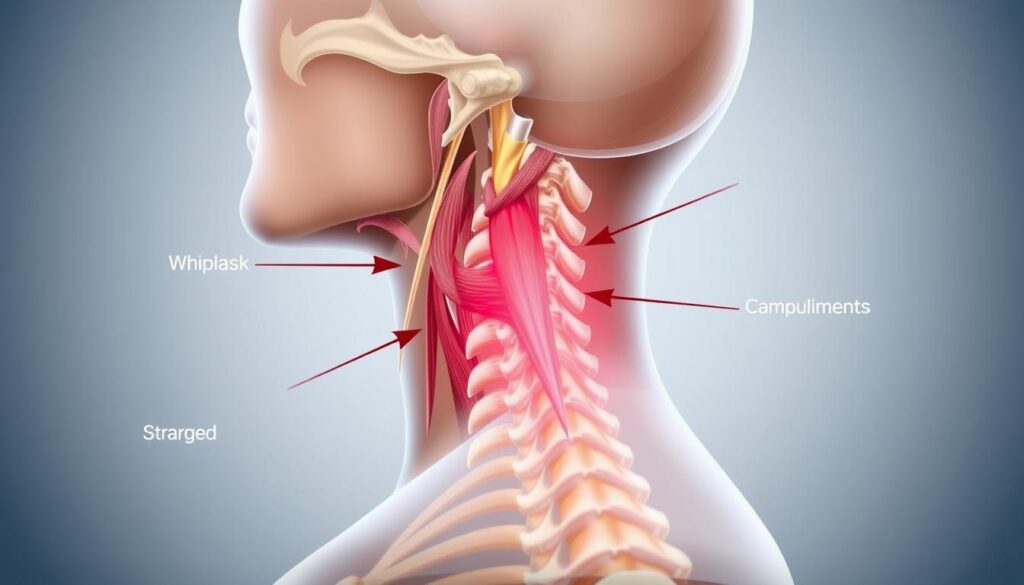Neck injuries can happen suddenly, causing pain and confusion. Whiplash is a cervical strain from rapid forceful movements1. It often results from car crashes or sports accidents, affecting daily life and mobility.
Recognizing whiplash symptoms is key to recovery. You may feel neck pain, stiffness, and shoulder discomfort1. Dizziness can also occur. These signs may appear within days and vary in strength.
Medical imaging helps assess whiplash damage. X-rays show bone issues, while CT scans give detailed bone pictures2. MRI scans reveal soft tissue injuries, guiding treatment plans.
Key Takeaways
- Whiplash is a sudden neck injury caused by rapid back-and-forth movement
- Symptoms can include neck pain, stiffness, and dizziness
- Multiple diagnostic tools help assess injury severity
- Most whiplash injuries recover within weeks to months
- Professional medical evaluation is crucial for proper treatment
What is Whiplash and Its Common Causes
Whiplash is a painful neck injury that can affect your daily life. It happens when your head jerks backward and forward rapidly. This sudden motion can harm neck muscles and tissues3.
Many link whiplash to car accidents. However, it can occur in various situations.
- Rear-end car crashes
- Contact sports accidents
- Physical abuse
- Sudden falls
Understanding the Mechanism of Whiplash Injury
Whiplash forces your neck into an extreme range of motion. This can strain muscles, ligaments, and soft tissues3. Symptoms usually appear within days of the injury.
Common signs include:
- Neck pain
- Stiffness
- Headaches
- Tingling or numbness in arms
Risk Factors and Prevention Strategies
Some factors can make a whiplash injury more severe3:
| Risk Factors | Prevention Strategies |
|---|---|
| Previous whiplash injuries | Proper vehicle headrest positioning |
| Older age | Wearing protective sports gear |
| Existing neck or back pain | Practicing safe driving techniques |
| High-speed injuries | Maintaining good posture |
When to Seek Medical Attention
See a doctor if you have ongoing neck pain or limited motion after an accident. Get help if you notice neurological symptoms too. Most people recover within a few weeks with proper treatment3.
Some may need extended care. Quick action can boost your recovery chances.
“Early intervention can significantly improve your recovery from whiplash trauma”
Essential Treatment Options for Whiplash Recovery
Whiplash recovery needs a complete approach to pain management and healing. Your treatment plan depends on your injury’s severity and personal needs4. Physical therapy is key to restoring neck mobility and easing discomfort4.
Initial treatment aims to manage pain and inflammation. Here are effective strategies for whiplash recovery:
- Rest and ice application for the first 24 hours5
- Alternating heat and cold therapy5
- Over-the-counter pain medications like ibuprofen4
- Gentle whiplash exercises to restore range of motion4
Advanced pain management options include:
- Prescription pain medications for severe symptoms4
- Trigger point and epidural steroid injections4
- Manual manipulation techniques4
Alternative therapies can provide extra relief during your recovery. Research supports the use of complementary treatments such as:
- Acupuncture
- Massage therapy
- Chiropractic care
Consistency in treatment and a personalized approach are key to successful whiplash recovery4.
Each physical therapy program is tailored to your specific needs. It considers your age, medical condition, and injury severity5. Quick medical attention can prevent chronic issues and speed up healing4.
Conclusion
Your whiplash management approach is key to optimal recovery. Most patients see significant improvement over time. Understanding the recovery timeline helps set realistic expectations6.
Research shows promising results for whiplash patients. About 92-95% successfully return to work after treatment6. This highlights the positive potential for healing.
Long-term effects of whiplash can differ among individuals. Studies show that half of patients still report neck pain a year after injury7. Your doctor will create a personalized treatment plan for your specific needs.
Effective whiplash management needs patience and medical guidance. Simple neck exercises started early are most effective for recovery7. Stay proactive by following recommended treatments.
Attend regular check-ups and communicate openly with your medical team. This helps track progress and adjust treatments as needed. Remember, most people achieve successful rehabilitation from whiplash.
Work closely with healthcare professionals to optimize your recovery. This approach can minimize potential long-term complications. Stay positive and focused on your healing journey.
FAQ
What exactly is whiplash?
What are the most common symptoms of whiplash?
How long does whiplash typically take to heal?
What treatment options are available for whiplash?
Can whiplash be prevented?
When should I see a doctor after experiencing a potential whiplash injury?
Are there long-term complications from whiplash?
Can alternative therapies help with whiplash recovery?
Source Links
- Whiplash Injury – https://www.hopkinsmedicine.org/health/conditions-and-diseases/whiplash-injury
- Whiplash – Diagnosis and treatment – https://www.mayoclinic.org/diseases-conditions/whiplash/diagnosis-treatment/drc-20378926
- Whiplash – Symptoms and causes – https://www.mayoclinic.org/diseases-conditions/whiplash/symptoms-causes/syc-20378921
- Comprehensive Whiplash Treatment Options – Comfort Rehab & Chiropractic Center of Cedar Hill – Cedar Hill, TX Chiropractors – https://dallasaccidentandinjuryrehab.com/comprehensive-whiplash-treatment-options/
- Rehabilitation For Whiplash – Pain and Rehabilitation Physicians – Lathrup Village, MI – https://painrehabnow.com/services/physical-therapy/rehabilitation-for-whiplash/
- PDF – https://www.medicaljournals.se/jrm/content_files/download.php?doi=10.1080/16501970410030742
- A research synthesis of therapeutic interventions for whiplash-associated disorder: Part 1 – overview and summary – https://pmc.ncbi.nlm.nih.gov/articles/PMC2975531/
